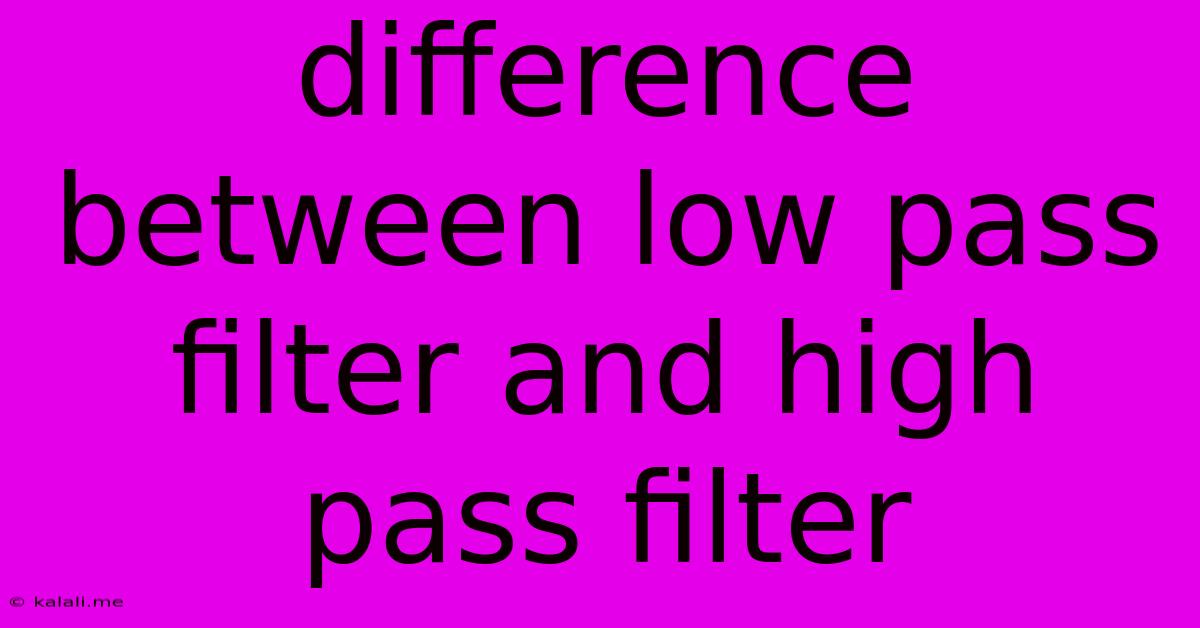Difference Between Low Pass Filter And High Pass Filter
Kalali
Jun 14, 2025 · 3 min read

Table of Contents
Low Pass Filter vs. High Pass Filter: A Comprehensive Guide
Meta Description: Understand the core differences between low pass and high pass filters. This guide explains their functionality, applications, and how they shape audio and other signals. Learn to choose the right filter for your needs.
Choosing the right filter for your application can be crucial. This guide dives into the fundamental differences between low pass filters (LPFs) and high pass filters (HPFs), exploring their characteristics, applications, and how they impact signals. We'll cover everything you need to know to confidently select the best filter for your specific needs.
What is a Filter?
Before delving into the specifics of low pass and high pass filters, let's establish a basic understanding of what a filter is. In signal processing, a filter is a device or process that selectively removes unwanted frequencies from a signal while allowing desired frequencies to pass through. Think of it as a sieve for sounds or data, letting certain elements pass while blocking others.
Understanding Low Pass Filters (LPFs)
A low pass filter allows frequencies below a specific cutoff frequency to pass through relatively unimpeded, while attenuating (reducing the amplitude of) frequencies above the cutoff frequency. Imagine it as a gate that only lets the "low" frequencies pass.
Key Characteristics of LPFs:
- Cutoff Frequency (fc): This is the frequency at which the filter starts significantly attenuating the signal. Frequencies below fc are largely unaffected, while those above are progressively weakened.
- Roll-off Rate: This describes how quickly the filter attenuates frequencies above the cutoff frequency. A steeper roll-off means a more abrupt transition between the passband (frequencies below fc) and the stopband (frequencies above fc).
- Attenuation: This refers to the reduction in amplitude of the frequencies in the stopband. A higher attenuation means a more effective filtering of unwanted frequencies.
Applications of LPFs:
- Audio Processing: Removing high-frequency noise or hiss from audio recordings. Think of it as smoothing out harshness.
- Image Processing: Blurring images by smoothing out high-frequency details.
- Control Systems: Filtering out high-frequency noise from sensor readings to improve stability.
Understanding High Pass Filters (HPFs)
Conversely, a high pass filter allows frequencies above a specific cutoff frequency to pass through, while attenuating frequencies below the cutoff frequency. This acts like a gate, only permitting the "high" frequencies to pass.
Key Characteristics of HPFs:
- Cutoff Frequency (fc): Similar to LPFs, this is the frequency at which the filter starts significantly attenuating the signal. Frequencies above fc are largely unaffected, while those below are progressively weakened.
- Roll-off Rate: Describes the speed of attenuation below the cutoff frequency. A steeper roll-off signifies a sharper transition between passband and stopband.
- Attenuation: The reduction in amplitude of frequencies in the stopband. Higher attenuation means better elimination of unwanted low frequencies.
Applications of HPFs:
- Audio Processing: Removing low-frequency rumble or hum from audio recordings. This helps clean up the audio signal.
- Image Processing: Sharpening images by enhancing high-frequency details.
- Control Systems: Removing slow, drifting signals from sensor readings.
Key Differences Summarized:
| Feature | Low Pass Filter (LPF) | High Pass Filter (HPF) |
|---|---|---|
| Passband | Below cutoff frequency | Above cutoff frequency |
| Stopband | Above cutoff frequency | Below cutoff frequency |
| Effect on Signal | Smooths, reduces high frequencies | Sharpens, reduces low frequencies |
| Typical Applications | Noise reduction (high frequency), blurring | Noise reduction (low frequency), sharpening |
Choosing the Right Filter
The choice between an LPF and an HPF depends entirely on the specific application and the type of signal processing required. Consider what frequencies you want to keep and which ones you want to remove. If you need to eliminate high-frequency noise, an LPF is the solution. If low-frequency hum is the problem, an HPF is the answer. Understanding these core differences will equip you to make informed decisions in your signal processing endeavors.
Latest Posts
Latest Posts
-
Find Equation Of Plane Through Point And Parallel To Plane
Jun 14, 2025
-
1 Mole Of O2 In Grams
Jun 14, 2025
-
What Are All Factors Of 8
Jun 14, 2025
-
Choose The Correct Html Element For The Largest Heading
Jun 14, 2025
-
Light Wave Is Longitudinal Or Transverse
Jun 14, 2025
Related Post
Thank you for visiting our website which covers about Difference Between Low Pass Filter And High Pass Filter . We hope the information provided has been useful to you. Feel free to contact us if you have any questions or need further assistance. See you next time and don't miss to bookmark.